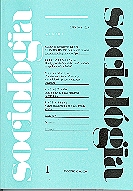Veřejnost a kriminalita v ČR: trendy vývoje
The Public and the Crime Rates in the Czech Republic: Trends of Development
Author(s): Jiří BuriánekSubject(s): Social Sciences
Published by: SAV - Slovenská akadémia vied - Sociologický ústav
Keywords: Public; crime rates; development; Czech Republic
Summary/Abstract: The Public and the Crime Rates in the Czech Republic: Trends of Development. The author considers his own concept of the “patient society” in relation to the development in the CR after 1989. After first wave of crime rates increase (index 3.3) and after short term period (1994-1996) of stabilisation, last year there was a 5% rise in crime. However the level of fear of crime remained unchanged. The problem of crime continues to top the ladder of perceived contemporary problems, but the weight attached to economic factors in the context of economic recession is increasing. The trust in institutions continues to be among the stabilising elements, and there have been no striking changes in the area of punitive or xenophobic attitudes. Public satisfaction with the work of the police has even slightly increased. More significant social differentiation in attitudes to crime and trust in institutions have been identified: both trust and willingness to co-operate with the police, for example, correlating positively with social status. Research on victimisation confirms its growth among the highest social strata as well as a slight increase among the lowest strata (the average for the whole population is roughly 30% victims of crime over the year). The most interesting finding is bright difference in level of fear related to place of residence. While fear of crime is naturally higher in the large towns, the pattern is different in Prague. The inhabitants of Prague have currently adapted to their clearly higher level of crime and that a kind of more general trend, the effect of “risk normalisation” is at work there. The deepening social differentiation of society in relation to the phenomenon of crime is beginning to be reflected in the attitudes of youth and is making it essential to consider the question of more comprehensive and multifactorial sociological analysis and explanation. The respondents from the survey of the Czech population cited (1998, N=1719), expressed the greatest fear of economic (property) crime, and in doing so were reacting relatively realistically. Nevertheless, the ”realism” of the public opinion ought not to be regarded as the main criterion for the evaluation of practical policies. The results confirm the plausibility of Merton’s concept of anomie (in the respect of relative social deprivation), and one cannot therefore rule out the shift of a previously stabilised and patient Czech public to reactions that might be described as “intimidated”, “stressed”, or even “wild”.
Journal: Sociológia - Slovak Sociological Review
- Issue Year: 2000
- Issue No: 1
- Page Range: 80-97
- Page Count: 18
- Language: Czech

